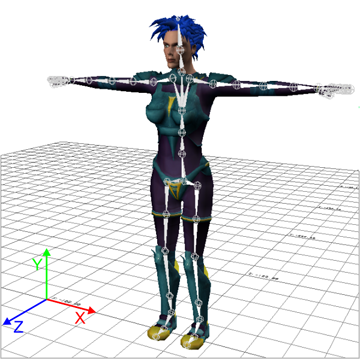Before you can use the Definition tab to map the bones in your character's skeleton to the nodes understood by the HumanIK solver, you must set up your character in a basic T-stance that provides HumanIK with crucial information about the proportions of your character's skeleton and its joint transforms.
Your character's T-stance must match the description and example given below as closely as possible in order for the inverse kinematics and retargeting solvers to produce accurate results for your character. Without a properly configured T-stance, the solvers will base all of their operations on faulty data, and will likely produce skewed, awkward or unexpected poses.
The T-stance has the following requirements:
- The character must face along the positive direction of the Z-axis.
- The arms must be spread along the X-axis. The left arm should therefore be pointing along the positive direction of the X-axis.
- The top of the character's head must be up, in the positive direction of the Y-axis.
- The character's hands are flat, palms facing the ground, with the thumbs parallel to the X axis.
- The character's feet need to be perpendicular to the legs (with the toes pointing along the Z-axis as shown). The feet must not be rotated around the Y-axis (meaning the toes of the left foot should not point inward toward the right leg or outward away from the right leg).
A typical T-stance is shown in the following image:

Quadrupeds
HumanIK can be used to control quadrupeds as well as bipeds. If you are creating a characterization for a quadruped character, you must set up the character's skeleton in the same T-stance shown above. Although this biped T-stance is awkward for a quadruped, you must set up your character in this biped stance in order to ensure that HumanIK is correctly set up with the proportions of your character's skeleton.
